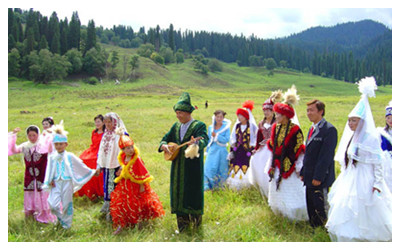Ethnic Groups in Xinjiang

Xinjiang Uygur Autonomous Region has, since ancient times, been populated by many ethnic groups, including a great number of nomadic tribes and nations. By the end of the 19th century, 13 major ethnic communities had established themselves there: the Uygurs, Hans, Kazaks, Mongolians, Huis, Kirgizs, Manchus, Xibes, Tajiks, Daurs, Ozbeks, Tatars and Russians. The Uygurs comprised the majority, and this multiethnic pattern remains even today.
Once called the "Western Region," Xinjiang includes China's northwest frontier in the heartland of Eurasia. It covers 1,664,900 square kilometers, one-sixth of the country's area, and shares a 5,600 km border with eight neighboring countries. According to the 2003 census, its population was 19,339,500, 39.9 percent of whom belonged to the Han ethnic majority. One of five autonomous regions in China, Xinjiang is home to 47 ethnic groups.
In 138 BC, the Han Dynasty imperial court sent Zhang Qian as special envoy to the "Western Region" to forge alliances with local tribes against border harassment from the Huns. In 121 BC, the Han army defeated the Huns at the "River-West Corridor" in Gansu Province and established four frontier prefectures: Wuwei, Zhangye, Jiuquan and Dunhuang. In 101 BC, the Western Han Dynasty stationed hundreds of garrison troops south of the Tianshan Mountains to guard the border and cultivate the land. Later in 60 BC, the Han Dynasty set up a "Western Region Frontiers Command" in Xinjiang, taking up sovereignty over the region. Xinjiang hence became an integral part of the multiethnic Chinese nation.
Xinjiang's 13 major ethnic groups have been involved in constant migration due to great changes in the natural environment. These population movements have caused religious and cultural intermingling, producing the region's present unique customs. These are expressed through diet, costume, wedding and funeral ceremonies, as well as religious beliefs, values, taboos and art. It is no wonder that whoever visits is deeply impressed by Xinjiang's rich cultural diversity.
13 Ethnic Minorities in China's Xinjiang Region
|
Uygur Nationality Population:8,823,500. Living Areas: Hotan, Kashi and Aksu. |
Kazak Nationality Population:1,352,100. Living Areas: Ili, Tacheng, Altay, Barkol, Jichang & Urumqi. |
|
Hui Nationality Population:866,700. Living Areas: All over Xinjiang. |
Kirgiz Nationality Population:173,700. Living Areas: Kizilsu Kirgiz Autonomous Prefecture. |
|
Mongolian Nationality Population:166,900. Living Areas: Bayangolen and Bortala prefectures. |
Tajik Nationality Population:40,900. Living Areas: Taxkorgan Tajik Autonomous County. |
|
Xibe Nationality Population:40,300.Living Areas: Charbur Xibe Autonomous County in Ili |
Manchu Nationality Population:23,900. Living Areas: Urumqi, Ili, Jichang and Hami. |
|
Uzbek Nationality Population:14,600. Living Areas: Kashi, Yining, Tacheng, Urumqi, etc. |
Russian Nationality Population:11,100. Living Areas: Ili, Tacheng, Altay and Urumqi. |
|
Daur Nationality Population:6,700.Living Areas: Axier Daur Township in Tacheng. |
Tatar Nationality Population:4,900.Living Areas: Mainly in northern Xinjiang. |

 Ask Questions ?
Ask Questions ?